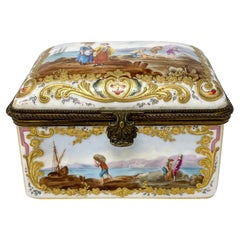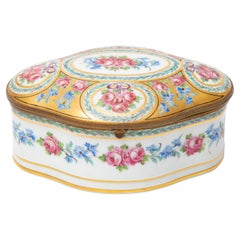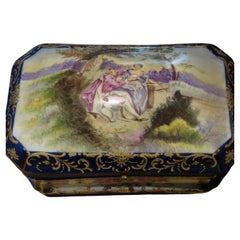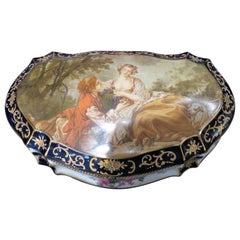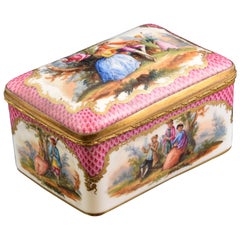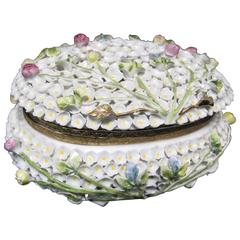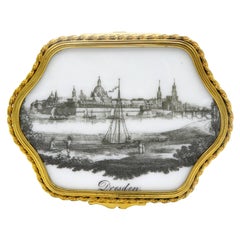Dresden Porcelain Box
Antique Mid-19th Century German Decorative Boxes
Porcelain
Antique 1880s German Decorative Boxes
Enamel, Ormolu
20th Century French Decorative Boxes
Porcelain
20th Century French Decorative Boxes
Crystal
Antique Late 19th Century German Neoclassical Revival Decorative Boxes
Other
Recent Sales
Antique 19th Century Baroque Decorative Boxes
Porcelain
Antique Mid-19th Century German Porcelain
Porcelain
Antique Late 19th Century Decorative Boxes
Porcelain
Antique 19th Century German Victorian Jewelry Boxes
Porcelain
Antique Mid-19th Century German Victorian Jewelry Boxes
Bronze, Ormolu
Antique 19th Century German Figurative Sculptures
Porcelain
People Also Browsed
Early 20th Century American Art Nouveau Table Lamps
Bronze, Wire
21st Century and Contemporary Turkish Classical Greek Busts
Statuary Marble
Mid-20th Century French Hollywood Regency Jewelry Boxes
Amethyst, Metal, Brass
Antique 18th Century Italian Baroque Paintings
Paint
Early 20th Century German Art Nouveau Decorative Boxes
Brass
2010s American Other Abstract Sculptures
Multi-gemstone, Rock Crystal, Amethyst, Malachite, Opal, Crystal, Quartz...
Antique 19th Century French Jewelry Boxes
Ormolu
Early 20th Century Italian Art Deco Dining Room Tables
Rattan
Late 17th Century Old Masters Landscape Paintings
Cotton Canvas, Canvas, Oil
21st Century and Contemporary Italian Animal Sculptures
Crystal, Gold Plate, Brass
21st Century and Contemporary American Taxidermy
Glass, Wood
20th Century Hungarian Porcelain
Porcelain
20th Century French Régence Jewelry Boxes
Bronze, Ormolu
Vintage 1920s French Art Deco Glass
Glass
Antique Late 19th Century American Aesthetic Movement Sterling Silver
Sterling Silver
Antique Early 1900s Italian Hollywood Regency Jewelry Boxes
Ormolu
Dresden Porcelain Box For Sale on 1stDibs
How Much is a Dresden Porcelain Box?
Finding the Right Boxes for You
From mere trinkets to useful receptacles that serve a distinct purpose, antique boxes as decorative objects have come in many forms over the years. No matter what they’re made of or where they end up in your home, decorative boxes add both style and storage to your space.
The decorative box that is likely most common is the jewelry box. These boxes were originally known as jewel caskets and were in common use in Ancient Egypt, as most Egyptians wore some sort of jewelry. A portable jewelry box, in its original intended use, was integral to keeping your jewelry safe and secure. This accessory has transformed in size, shape and appearance over the years. Initially it was common for a jewelry box to bear intricate ornamentation. Whether they’re mid-century modern works of marble and brass or feature playful Art Deco–style geometric decor, jewelry boxes boast real staying power.
Snuff boxes began to soar in popularity during the 17th century (and were commonplace in European homes by the mid-19th century). The boxes, some hand-painted with landscape scenes, some made from gold, porcelain or stone, contained a small amount of tobacco, which users would sniff, or “snuff,” throughout the day. Some particularly ornamental snuff boxes featured enameled designs or were set with precious gems and were given as gifts or party favors, particularly at the coronation of royalty or other lavish events.
Whether you’re organizing important mail in the foyer or tucking away medications in your bathroom, antique boxes — be they metal tea caddies, sterling-silver decorative boxes or Victorian cigar boxes made of oak (even if you don’t smoke) — are a sophisticated solution to help keep the surfaces in your home clutter-free. And no matter if you’re seeking a decorative box to beautify a desktop or bestow upon a loved one, you are sure to find something you love in the collection of antique and vintage boxes on 1stDibs.
- 1stDibs ExpertApril 22, 2024The famous porcelain from Dresden is usually just referred to as Dresden porcelain. However, its maker is Sächsische Porzellan-Manufaktur Dresden GmbH, which translates to Saxon Porcelain Manufactory in Dresden Ltd. The company opened in Potschappel, a suburb of Freital in the Sächsische Schweiz-Osterzgebirge district of Dresden, in 1872. Find a variety of Dresden porcelain on 1stDibs.
- 1stDibs ExpertMay 3, 2024The history of Dresden Porcelain began with the founding of Sächsische Porzellanmanufaktur Dresden by Carl-Johann Gottlob Thieme in 1872 in the city of Freital, Saxony. During the decades that followed, his son-in-law Carl August Kuntzsch joined the company and pioneered the process of adding ornate floral ornamentation to porcelain. When Thieme died in 1912, Kuntzsch took up the reins of Dresden Porcelain. The company saw a decline during World War I and II. During the period after the Second World War, the Soviet Union gradually assumed control of Dresden Porcelain, renaming it VEB Sächsische Porzellan-Manufaktur Dresden. The reunification of Germany in 1990 allowed the company to return to private ownership. A French investor group purchased it in 1991 and then sold it to the Dresden IPV group, led by art patron Jürgen Wegener, in 1993. Gunther Seifert and Klaus-Peter Arnold bought out the group following its bankruptcy in 1998, only to resell it to Geschwister Hillebrand GmbH in 2005. Explore a selection of Dresden Porcelain on 1stDibs.
Read More
How a Craving for Color Revolutionized Glass
After synthetic dyes changed fashion, home goods and printed matter, it was only a matter of time till glass caught up.
Kazuyo Sejima’s Flowering Tree Blooms Year-Round
The brilliantly simple design turns a modest bouquet into a major statement.
He Wrote ‘Oedipus Rex,’ but Do You Know What He Looked Like?
The Greek tragedian is said to have been handsome in his day.
Cigar Culture Was Once the Peak of Masculinity. Now, It’s a Compelling Curiosity
Even for those who don’t indulge, elegant smoking accessories and audacious art portraying cigar enthusiasts hold a nostalgic allure.
African Travel Plans on Hold? This Ardmore Leopard Vase Brings the Beauty of the Savanna to You
It’s an excellent example of the sought-after ceramics coming out of South Africa’s KwaZulu-Natal province.
With a High-Tech Flagship and Cool Collabs, Lladró Is Breaking the Mold for Porcelain Production
Thanks to its new leadership, the Spanish maker of figurines, busts and lighting is on a mission to update the art of porcelain for the 21st century.
Zoë Powell’s Magnolia 05 Vessel Is Handmade from Clay She Unearthed Herself
The free-form stoneware piece is inspired by the magnolia tree and its associations with home.
8 Ways to Breathe New Life into a Space with Plants
The pair behind the Instagram account @houseplantclub share their tips for making any room of the house gloriously green.
